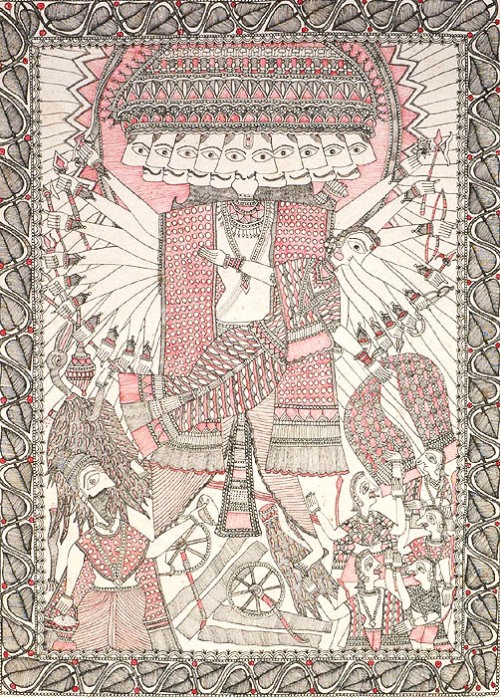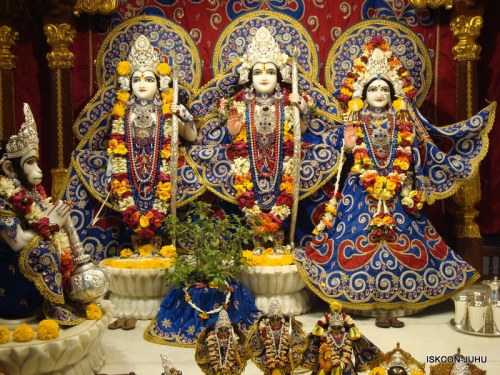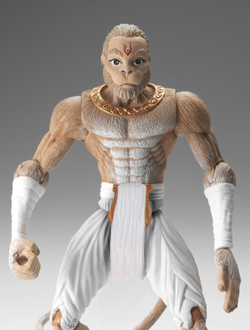Earlier this month we celebrated Rāma-navamī, the appearance of Rāmacandra. That occasion offered me the opportunity to provide our congregation with the real import of Rāma-līlā, explaining what the activities of Rāmacandra reveal to us about our own lives in this world.
The story of Rāma is widely known. The original Rāmāyaṇa, Vālmīlki’s epic Sanskrit verse narration, remains revered, much read and recited. The work has spawned myriads of retellings in vernacular languages on the Indian subcontinent and across Southeast Asia as well. Many of these have become famous in their own right. More recently, narrative has been taken up by other media: a multitude of popular films, feature-length animations, television series, and, last but not least, comic books or “graphic novels,” all these broadcast the story of Rāma.
For all that, the meaning of Rāmāyaṇa—as I discovered to my surprise—remains almost completely unknown, even to its ardent fans. Famous though it is, the knowledge it conveys remains hidden. Secret, in other words. Esoteric.
I am privileged to know that secret only because Prabhupāda disclosed it. And I have disclosed it in turn. So it is, and has always been, an open secret. It is hiding in plain sight: present for all to see, yet none of us can apprehend it until we’re prepared to recognize it. Until we are no longer—as the psychologists say—“in denial.”
Rāmacandra is an avatāra, a descent of God, come to reveal himself to us here below. Rāmacandra descended together with his consort Sītā-devī. In his earthly pastime, Rāma, prince of Ayodhyā, won Sītā, the dark-eyed daughter of Janaka, king of Mithilā, as his bride. Thus a disclosure, and central plot-point, of Rāmāyaṇa is that God is not a bachelor.
As the Supreme Personality of Godhead, Lord Rāmacandra is not only a person but the embodiment of ultimate metaphysical principles as well. The Personality of Godhead is, as the Bhagavad-gītā says, “paraṁ brahman” the “supreme Brahman.” Brahman is defined in the Vedānta-sutra 1.1.1. as janmādy-asya yataḥ “that from which everything emanates,” or the ultimate source of all energies. The entire creation, material and spiritual, is the energy of God. As Rāmacandra is the embodiment of Brahman, Sītā is the embodiment of the energy of Brahman, technically the svarūpa-śakti.
In the transcendent kingdom of God, Vaikuṇṭha, the Lord reigns in all opulence and greatness as Nārāyaṇa, “the abode of all beings;” his eternal consort is Mahā Lakṣmī, the “supreme Goddess of Fortune.” All the opulence and auspiciousness of the Lord’s kingdom abide in her. And she, in turn, belongs exclusively to him.
This divine pair descends into the material world as Sītā and Rāmacandra. The material world is part of the kingdom of God, but it is a sequestered region where fallen souls can deny or forget God. All are here because of envy of the Lord; the illusory energy, māyā, enables the denial of reality by them and facilitates their endless, vain projects to dominate and enjoy all the recourse of nature.
Sītā and Rāmacandra descend to attract and enlighten the fallen souls.
In the drama that Sītā and Rāma enact for us, a palace intrigue is instigated that forces Rāma to go into exile on the very eve of his coronation. For fourteen years he must live in the wilderness. His brother Lakṣmaṇa and his wife Sītā elect to accompany him and share his hardship.
In their jungle camp, Sītā becomes abducted by Rāvaṇa, the wealthy, powerful, and breathtakingly ambitious tyrant of the island kingdom of Laṇkā.
The powerful and crafty Rāvaṇa, with ten heads and twenty arms, carries away Sītā.
Aggrieved and enraged, Rāma vows to recover Sītā, and eventually he is aided in this by a tribe of Vānaras, a monkey-like race; they are led by the powerful son of Vāyu, god of the wind. This is Hanumān, the proto-superhero who reveals himself as fully devoted servant of Rāma.
Sītā-Rāma, Lakṣmaṇa, and Hanumān are worshiped together in temples. Here they are as they appear in ISKCON’s popular Juhu, Mumbai temple:
Rāmacandra, in the center, is the Supreme Personality of Godhead. Sītā, standing on his left, is his internal spiritual potency, svarūpa-śakti. On Rāma’s right is his brother Lakṣmaṇa, who is the Lord’s plenary expansion. And Hanumān, offering obeisance at their feet, is the Lord’s pure devotee. Belonging to the category of the innumerable eternal spirit souls (jīvas) who comprise the Lord’s marginal potency, Hanumān exemplifies the fully liberated or enlightened jīva.
Sītā belongs by the side of Rāma, just as Lakṣmī is always with Nārāyaṇa. Yet Lakṣmī has long been worshiped and prayed to separately from Nārāyaṇa, invoked as the goddess of fortune to bless the petitioner with wealth and good luck. Here is Lakṣmī in that aspect:
It is not too difficult to see a path from this to the more secular icon of American gamblers, a much-venerated personage typically decorated with standard symbols:
In a similar fashion, Hanumān has been popularly worshiped independently of Rāma for a long time. Typically he is propitiated in order to gain physical strength. Once, while exploring the spacious Jagannātha Vallabha gardens in Purī, I came upon a small temple to Hanumānji. His image on the altar seemed to be well cared for by a team of pūjārīs, all young men wearing brahmacarī saffron over their bulked up bodies. When not engaged in pūjā, they spent their time diligently exercising, lifting weights, and practicing martial arts.
Next to our temple in Juhu there is a municipal vest-pocket park maintained by ISKCON. It has an attractive oval walking path, paved in ocher tile, used by many locals for daily constitutionals. In the evenings, devotees chanting japa join them. On one side, a playground with good equipment attracts an animated crowd of yelling children. Next to the playground, a long shed-like building fills up with young men and boys strenuously working out with weights. They don’t neglect to pay their respects to Hanumān, who occupies an altar in a small room set aside for him.
Hanumān’s growing world-wide popularity recently elicited a long article in the in-flight magazine of Jet Airways, which I read with interest while flying from Kolkata to Mumbai.
In Trinidad, members of the Indian community have constructed an eighty-five-foot high outdoor statue of Hanumān. The abhiśeka, or ritual bathing, necessitates a unique innovation:
Hanumān is the hero of “Hanumān Returns,” a 2007 full-length Hindi animated film:
And there is—how could there not be?—a Hanumān action figure:
And so the world, in various ways, implicitly or explicitly disassociate Lakṣmī and Hanumān from Rāma, and by so doing lose access to the meaning of Rāmāyaṇa.
Hanumān is indeed our hero, our exemplar, our role model. And Sītā or Lakṣmī-devī requires our deepest veneration. Here, commenting on Śrīmad Bhāgavatam (2.7.23) Prabhupāda reveals the secret:
Sītā is Lakṣmīji, or the goddess of fortune, but she is never to be enjoyed by any living being. She is meant for being worshiped by the living being along with her husband, Śrī Rāmacandra. A materialistic man like Rāvaṇa does not understand this great truth, but on the contrary he wants to snatch Sītādevī from the custody of Rāma and thus incurs great miseries. The materialists, who are after opulence and material prosperity, may take lessons from the Rāmāyaṇa that the policy of exploiting the nature of the Lord without acknowledging the supremacy of the Supreme Lord is the policy of Rāvaṇa. Rāvaṇa was very advanced materially, so much so that he turned his kingdom, Laṅkā, into pure gold or full material wealth. But because he did not recognize the supremacy of Lord Rāmacandra and defied Him by stealing His wife, Sītā, Rāvaṇa was killed, and all his opulence and power were destroyed.
In a lecture on Bhagavad-gītā 2.6 (London, August 6, 1973), Prabhupāda expounds on the role of Hanumān:
So Hanumān, a great fighter, fought with Rāvaṇa, but not for his personal interest. The interest was how to get out Sītāji from the hands of Rāvaṇa, kill the whole family and get out, and let her sit down on the side of Rāmacandra. This is the policy of Hanumān, of devotees. And the Rāvaṇa policy is “Take away Sītā from the clutches of Rāma and enjoy her.” This is Rāvaṇa policy. And the Hanumān policy is: “Take out Sītā from the hands of Rāvaṇa and get her seated by the side of Rāma.” The same Sītā. Sītā means Lakṣmī, wealth. So Lakṣmī means Nārāyaṇa’s property, God’s property.
In other words: All natural resources, all the bounty of nature, does not belong to us but to God, just as Sītā belongs Rāma. Any who attempt to exploit those resources for their own gain and aggrandizement, are like Rāvaṇa, advancing their own project to compete with God. They will invariably lose; their wealth and opulence will prove illusory. The sacred and heroic task appointed to the godly, then, is to see that all the world’s wealth and resources are restored to the their rightful owner, as Hanumān restored Sītā to the side of Rāmacandra. Note that in battling Rāvaṇa for Sītā, Hanumān was innocent of any desire of her for himself. This is what is meant by saying he is Rāma’s pure servant.
In its avarice for global economic development, the world has increasingly taken to the policy of Rāvaṇa; it will not be able to understand the secret of Rāmāyaṇa. Yet we have also recently seen wealth counted in billions and billions of dollars suddenly vanish into thin air. Prabhupāda gives the reason:
Riches come from Lakṣmī, the goddess of fortune, and the goddess of fortune is the property of Nārāyaṇa, the Supreme Personality of Godhead. The goddess of fortune cannot stay anywhere but by the side of Nārāyaṇa; therefore another of her names is Cañcalā, restless. She cannot be peaceful unless she is in the company of her husband, Nārāyaṇa. For example, Lakṣmī was carried away by the materialistic Rāvaṇa. Rāvaṇa kidnapped Sītā, the goddess of fortune belonging to Lord Rāma. As a result, Rāvaṇa’s entire family, opulence and kingdom were smashed, and Sītā, the goddess of fortune, was recovered from his clutches and reunited with Lord Rāma. Thus all property, riches and wealth belong to Kṛṣṇa.
Everyone now feels tremors that we fear are the first rumblings of kingdoms smashing. Many hope President Barack Obama can save us. It is interesting, in this regard, that the President happens to always carry a talisman of Hanumān, acquired when he lived in Indonesia:
Is it too much to hope that he can come to understand the meaning of Rāmāyaṇa and follow in the footsteps of Hanumān? We can pray.









Obama is carrying a Hanuman with him, whow! Where do you get to know all this?